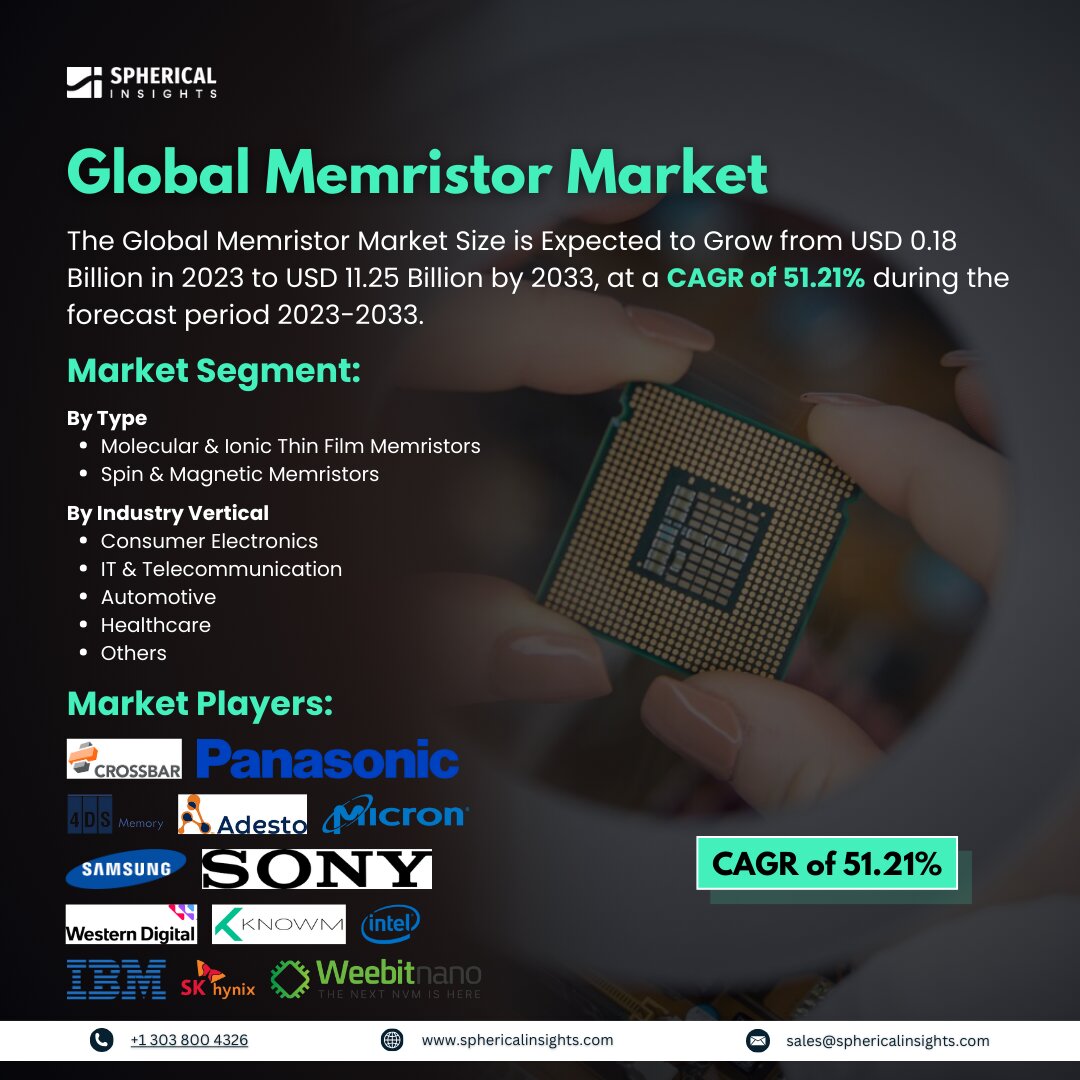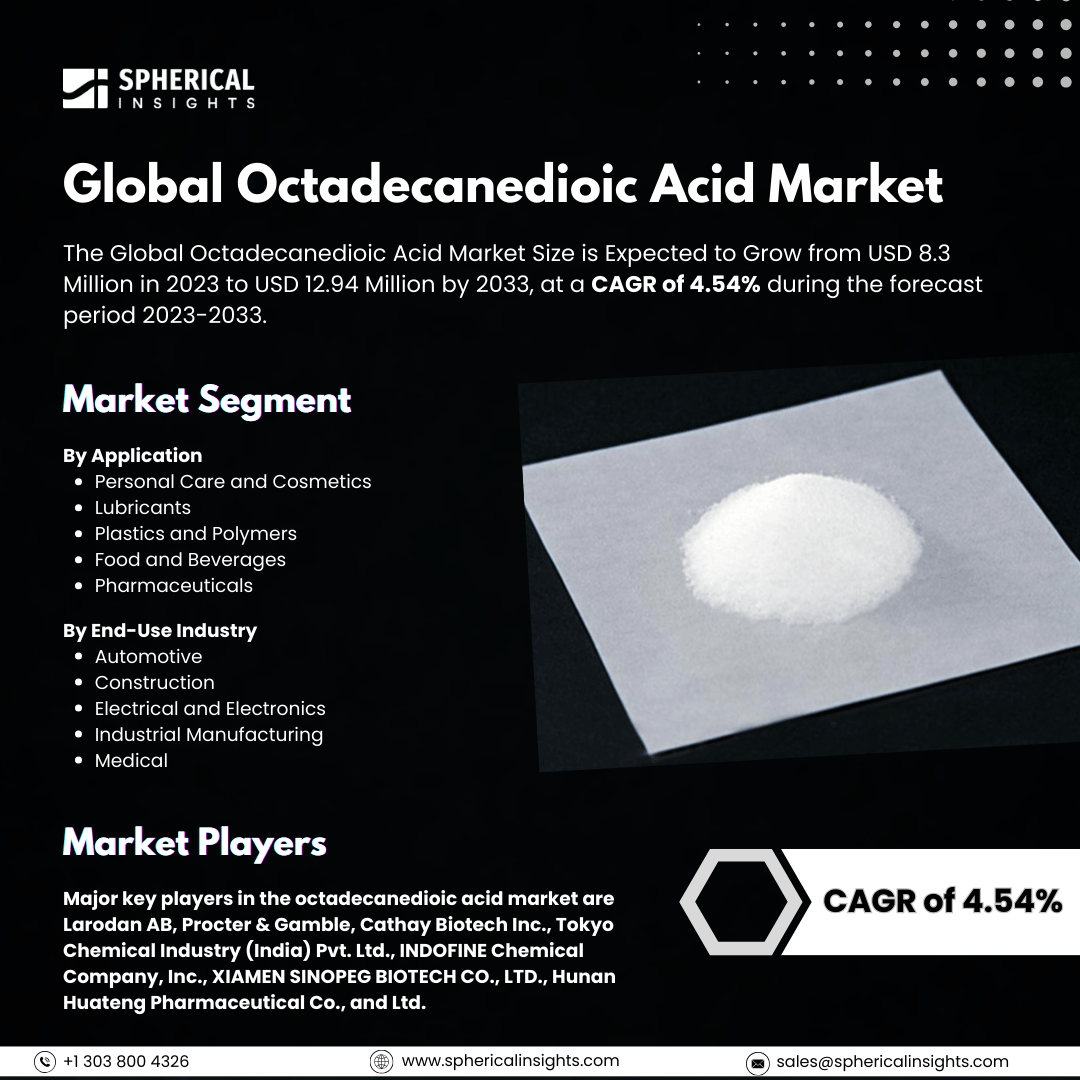Global Memristor Market Size to worth USD 11.25 Billion by 2033
According to a research report published by Spherical Insights & Consulting, the Global Memristor Market Size is Expected to Grow from USD 0.18 Billion in 2023 to USD 11.25 Billion by 2033, at a CAGR of 51.21% during the forecast period 2023-2033.
Browse key industry insights spread across 210 pages with 110 Market data tables and figures & charts from the report on the Global Memristor Market Size, Share, and COVID-19 Impact Analysis, By Type (Molecular & Ionic Thin Film Memristors and Spin & Magnetic Memristors), By Industry Vertical (Consumer Electronics, IT & Telecommunication, Automotive, Healthcare, and Others), and By Region (North America, Europe, Asia-Pacific, Latin America, Middle East, and Africa), Analysis and Forecast 2023 – 2033.
The memristor market refers to a type of resistance-switching memory device that is capable of mimicking biological synaptic functions in artificial neural networks. The device is a type of memory device, characterized by its ability to change its resistance based on the history of the current or voltage previously applied. The contribution to the development of memristor-based edge AI devices that can process data locally with minimal power is providing lucrative opportunities in IoT, autonomous vehicles, and real-time data analytics, thereby escalating the market growth opportunity for memristor. The growing need for IoT, cloud computing, and big data as well as the surging demand for the application of automation robots are significantly contributing to driving the market. On the contrary, the complexity inherent in incorporating memristor technology into various technological applications is restraining the market growth for memristor.
The molecular & ionic thin film memristors segment held the largest revenue share and is expected to grow at the fastest CAGR during the forecast period.
Based on the type, the memristor market is classified into molecular & ionic thin film memristors and spin & magnetic memristors. Among these, the molecular & ionic thin film memristors segment held the largest revenue share and is expected to grow at the fastest CAGR during the forecast period. The vast operating temperature range and application of molecular & ionic thin film memristors in potential storage class memory are driving the segmental market growth.
The consumer electronics segment dominated the market with the largest market share during the forecast period.
Based on the industry vertical, the memristor market is classified into consumer electronics, IT & telecommunication, automotive, healthcare, and others. Among these, the consumer electronics segment dominated the market with the largest market share during the forecast period. Memristors are used in consumer electronics to make the devices more efficient, intelligent, and interconnected. The increased investment in the consumer electronics segment is contributing to propel the market growth.
North America is estimated to hold the largest share of the memristor market over the forecast period.
North America is estimated to hold the largest share of the memristor market over the forecast period. The increasing investment in R&D by the key market players and the presence of highly informed integrators based on memristor components in the region are responsible for propelling the market. The use of edge computing for processing data closer to the source in the telecommunication companies is significantly contributing to driving market growth for memristor. Further, the increasing collaborative initiatives among academic, industry, and government agencies fostering interdisciplinary collaboration and knowledge exchange are majorly responsible for market growth.
Asia Pacific is predicted to grow at the highest CAGR in the memristor market over the forecast period. The extensive application of memristors in electronic devices as well as a number of vehicles using memories in their electronic control unit and infotainment systems are anticipated to drive the market growth. The growing adoption of advanced technologies and the need for high-performance electronic components are bolstering the market growth.
Competitive Analysis
Major key players in the global memristor market include Crossbar Inc., Panasonic Corporation, 4DS Memory Limited, Adesto Technology, Micron Technologies Inc., Samsung Group, Sony Corporation, Western Digital Corporation, Knowm Inc., Intel Corporation, IBM Corporation, SK Hynix Inc., Weebit Nano Ltd., Fujitsu Ltd., Toshiba Corp., and Others.
Key Target Audience
- Market Players
- Investors
- End-users
- Government Authorities
- Consulting And Research Firm
- Venture capitalists
- Value-Added Resellers (VARs)
Recent Developments
- In February 2022, Neuromorphics, the neurocomputing platform for artificial intelligence, including the world’s first Neuromorphic Processing Unit (NPU)TM, announced it has raised a $25 million Series A, led by Prosperity 7 Ventures, joined by existing investors Buckley Ventures, Gaingels, Loup Ventures, Metaplanet and Pioneer Fund, among others.
- In February 2022, Intrinsic Semiconductor Technologies said it had successfully scaled its silicon oxide-based resistive random access memory devices (RRAM) and demonstrated electrical performance characteristics that would enable their use as high-performance, low-cost, embedded, non-volatile memory in logic devices at advanced processing nodes.
Market Segment
This study forecasts revenue at global, regional, and country levels from 2023 to 2033. Spherical Insights has segmented the memristor market based on the below-mentioned segments:
Global Memristor Market, By Type
- Molecular & Ionic Thin Film Memristors
- Spin & Magnetic Memristors
Global Memristor Market, By Industry Vertical
- Consumer Electronics
- IT & Telecommunication
- Automotive
- Healthcare
- Others
Global Memristor Market, By Regional Analysis
- North America
- Europe
- Germany
- UK
- France
- Italy
- Spain
- Russia
- Rest of Europe
- Asia Pacific
- China
- Japan
- India
- South Korea
- Australia
- Rest of Asia Pacific
- South America
- Brazil
- Argentina
- Rest of South America
- Middle East & Africa
- UAE
- Saudi Arabia
- Qatar
- South Africa
- Rest of the Middle East & Africa



